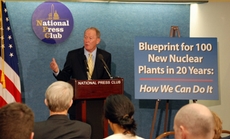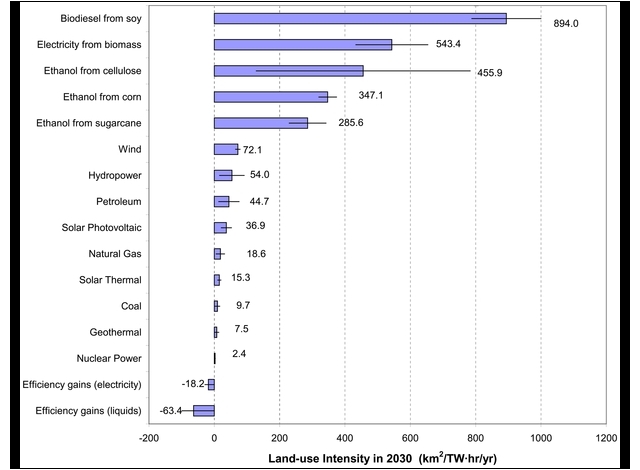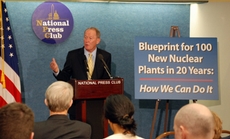 Alexander unveiled his nuclear plan in July.One of the few Congressional Republicans who talks about the need to address climate change, Sen. Lamar Alexander of Tennessee, made an interesting argument against wind and solar energy this week. He’s concerned about the amount of land required to produce energy from wind and solar, writing in the Wall Street Journal, “I fear we are going to destroy the environment in the name of saving the environment.”
Alexander unveiled his nuclear plan in July.One of the few Congressional Republicans who talks about the need to address climate change, Sen. Lamar Alexander of Tennessee, made an interesting argument against wind and solar energy this week. He’s concerned about the amount of land required to produce energy from wind and solar, writing in the Wall Street Journal, “I fear we are going to destroy the environment in the name of saving the environment.”
He draws on a recent study by Nature Conservancy scientists who detail how much land is required to produce energy from different sources, an issue they dub “energy sprawl.” Alexander focuses on a small part of their findings—that wind and solar plants require a good deal more physical space than nuclear plants:
This “sprawl” has been missing from our energy discussions. In my home state of Tennessee, we just celebrated the 75th Anniversary of the Great Smoky Mountains National Park. Yet there are serious proposals by energy developers to cover mountains all along the Appalachian chain, from Maine to Georgia, with 50-story wind turbines because the wind blows strongest across mountaintops.
Let’s put this into perspective: We could line 300 miles of mountaintops from Chattanooga, Tenn., to Bristol, Va., with wind turbines and still produce only one-quarter the electricity we get from one reactor on one square mile at the Tennessee Valley Authority’s Watts Bar Nuclear Plant.
It’s a disingenuous argument, because the problem with nuclear power has never been land use. (See Radioactive Waste Disposal, Cost, and Security for more on the very difficult nuclear question.) I’m not arguing here that Alexander’s dead wrong in his long-standing love for nuclear energy, just that this is a thin argument for nuclear.
Oh, and Alexander says he won’t support a cap-and-trade climate bill unless it includes his personal wish for 100 new nuke plants.
Bonus second point: If you’re an environmentalist who cares about endangered species and wild places, you shouldn’t be concerned about wind farms or solar plants. You should worry about biofuels.
At least, I’m having a hard time avoiding that conclusion after looking at a key graphic from the energy sprawl report:
 Courtesy PLoS ONE
Courtesy PLoS ONE
The chart measures the land required per unit (terawatt-hour) of electricity from different sources. Note that the top five sources are all for biofuels, derived from different crops. Note how much less land wind, solar voltaic and solar thermal energy require in comparison.
I won’t rehash the economic and ecological problems with biofuels here, but this should cool off the notion that wind and solar won’t fly for land-use reasons. Of course some places are more sensitive than others, but if there’s room for mountaintop removal coal mining, we have room for wind and solar plants.
There’s a certain man-bites-dog appeal in stories about environmentalists who oppose clean energy projects because they disrupt wild places and endangered species. Take the conflict over solar panels and transmission lines in the Mojave Desert. Or the quarrel over the Cape Wind project at Nantucket Sound. Or the fight over wind turbines in the Flint Hills of Kansas.
These conflicts are intriguing, sure. But the sprawl study, which appeared in PLoS ONE, the online journal of the Public Library of Science, suggests that biofuels such as ethanol pose a far greater threat to open lands.



